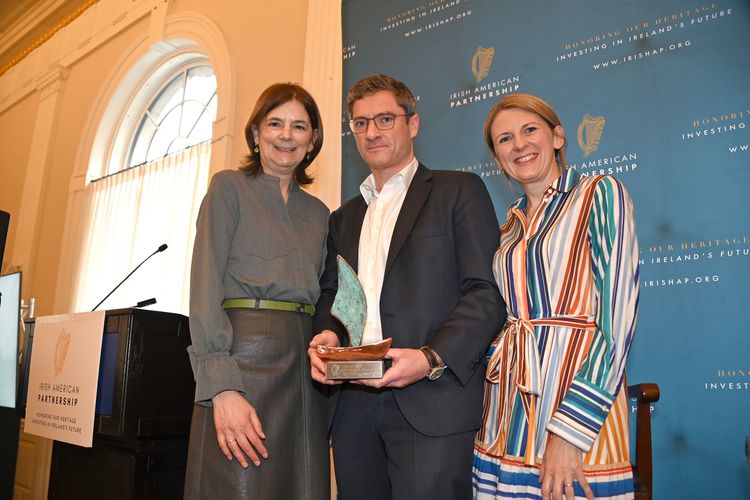Dublin-born interior designer Claire McGovern began her American career in San Francisco, but is now mainly based in New York.
PHOTO: PETER MCDERMOTT
By Peter McDermott
pmcdermott@irishecho.com
“A beautiful website isn’t enough.”
So said interior designer and art advisor Claire McGovern about doing business in New York City.
She showcases her work at the strikingly stylish rhymestudio.com, but the Dubliner said it’s another ingredient for success that stands out above others.
“Word of mouth is the strongest referral in my industry,” McGovern said. “Satisfied clients referring me to their friends is usually the model.”
“That takes some development,” she said. “You’re only as good as your relationships, the infrastructure that you develop.”
And when the introduction is made, the real work begins. “You need to be an excellent businesswoman or businessman in that situation,” she added. “You have to be charismatic, you have to be very compelling and you have to present yourself as extremely trustworthy.”
Sean Grayson, a financial professional with properties in both Manhattan and San Francisco, has participated in the word of mouth process.
"I have worked with Rhyme on a couple of occasions and have found their design proficiency and professionalism to be second to none,” Grayson said. “McGovern and her team are incredibly creative and distinguished problem solvers who can take on any kind of design challenge with ease.”
In a similar vein, Irish Homes & Interiors, a magazine based in her home city, referred to a recent New York project it featured as a "masterclass on excellent design.”
McGovern does “four or five” major projects a year in Manhattan and Brooklyn, ranging from private apartments to more public spaces like offices and restaurants. Robert F. Kennedy’s charity Waterkeeper at the World Trade Center is one notable recent client.
Related to her interior design work, and in collaboration RUX, McGovern has branded and launched Stickbulb, which, she said, advances “every architect’s dream to build with light.”
Her American story began when as part of her master’s degree in arts administration from University College Dublin, she got a six-month internship in 1997 in San Francisco.
“I fell in love with it,” said McGovern, who earned her primary degree at Trinity College Dublin.
Her West Coast apprenticeship continued with some respected firms, and then in 2002, she founded an art and design gallery in San Francisco. There, she curated two Irish government-sponsored exhibitions entitled “Hibernia of the New Millennium.”
Further exhibits, involving nationally- and internationally-known artists and designers, garnered for McGovern praise in Artweek, Interior Design, the San Francisco Chronicle, Furniture Today, Sunset Magazine and Image Interiors. In the process, she was responsible for multi-million dollar art and design sales, while also supporting rising stars in the California art scene.
Grayson, who has a vacation home in St. Barths, said: “McGovern introduced me to the world of collectable art. Her curatorial vision combined with such an informed design and art sensibility makes for a valuable business resource and service."
Practical and artistic
McGovern added skills in brand positioning, development and strategic marketing to her curatorial, interior architecture and design-consultation experience.
“I don’t have any formal degree in marketing or public relations, but I’ve taught myself,” said the Dubliner, who increasingly spent time in New York before formally opening an office in Brooklyn in 2009. “I could launch a design business tomorrow for other people, which I have done.”
McGovern, the daughter of an architect, learnt some of both the practical and artistic sides of the business early on. She gained work experience as a teenager in her late father’s practice in Dublin, Sean McGovern & Associates. However, her artistic sensibility, she believes, was more influenced by her mother, who was a teacher before being a stay-at-home mother to six children and is now a published poet.
That mix of business and the esthetic is always on McGovern’s mind. “My job is to develop artistic concepts related to that which might become custom furniture design, interesting, unusual finishes within an interior, [and] art concepts.
“That’s just the artistic program. The practical application of all of that is budgeting, project management, client approval for budgets, value engineering for specific products,” she said.
To explain value engineering, McGovern cited a hypothetical example of 50 tables and 150 chairs for a restaurant interior: “The client really likes the design of one, but it has to be procured at a much lower cost.
“And of course the installation,” she said, “after you get through the phases of project planning, planning permission for any alterations, remodeling, installation of new finishes with the contractor, the FF&E [furniture, furnishings and equipment] budget.
“The implementation of that is a whole other cost.” McGovern said: “As a designer or consultant who develops an interior concept for somebody’s home, you really have to deliver.
“They expect everything. Occasionally, even the role of therapist gets thrown in there,” she said, with a laugh.
“Since moving to America, in terms of provision of excellent service,” McGovern continued, “it’s something that I’ve become very accustomed to. I do think Irish people have the ability to be naturally friendly and welcoming and accommodating as a culture. But you see in America that ‘the customer is always right’ is the principle that pervades every single industry.
“And it’s taken a new level when someone is paying a premium price for redesigning their home or restaurant. You have to cover every single detail. There’s a standard of excellence that has to be maintained.”
McGovern adheres to the principles of “Gesamtkunstwerk” or “total design” and, like most designers is influenced by the some of the greats, such as Italian Carlo Mollino (1905-1973), “whose furniture lines and conceptual approach to design in my opinion are just unparalleled.”
Those of means are attracted to tradition in another way.
“In New York and in Silicon Valley, there’s definitely a consumer who appreciates the hand-crafted quality of furniture,” said McGovern, the mother of a 3-year-old boy.
As for pricing of the service, she said: “Interior designers work in a variety of ways. Most will offer a client the option of either a flat fee per project or an hourly rate. An hourly rate for a large project is obviously not cost effective. A flat fee on average might be 5-10 percent of total project budget.
“An hourly rate for New York City can be anything from $150-$400 on average,” she added.
Furniture collection
“Only the best survive,” she said, more generally. “Bidding on a job, you’re competing sometimes with two or three others. So you have to be competitive.”
A November 2014 report from the think-tank Center for an Urban Future argued that people running successful small businesses in New York understand “how much their product or service costs to produce at different scales and how to price their product competitively against their peers. And they understand their market well enough to know who their peers are—and who they aren’t.”
McGovern agrees with that, and can relate also to its authors’ finding that “the business owners we spoke with have moved beyond fetishizing their product to confidently embracing the business itself—what many experts refer to as working on the business instead of wholly in the business.”
As a young designer, she remembered, failure was the greatest education.
“You might have a brilliant idea,” she said, “but if it’s not commercially or financially viable after a year or 18 months, you have to pull the plug.”
The designer and art advisor, however, thought the report’s approach in one area didn’t necessarily apply in her industry. It looked for the “the secret sauce,” the factors that made individual businesses successful, and by extension the city’s economy, which it said would benefit if every small business added employees.
The Center for an Urban Future’s report said the “most successful firms we spoke with indicated that they envisioned growth almost from the moment they started their businesses.”
McGovern, who hired one part-time assistant in 2009 and another last year, believes that ambition is indeed essential. But simply thinking big isn’t the formula for success, in her view. Inspiration for the big idea might be necessary and that can come with time and experience.
For some time, she’s been involved in creating a furniture collection that is directly related to her identity as an Irish designer in America.
“In the case of launching a furniture collection – that’s a huge project right there,” McGovern said.
“It’s not limited to the creation and design of furniture,” she said. “You have to have a marketing plan. You need a business plan. You possibly need investments to get it out in the world.”
As for the potential consumer: “It certainly would have resonance in Ireland, though there’s a greater profitability in London, Germany, Paris, and the market in New York is huge,” McGovern said.
“You have to structure how the manufacturing of it is going to work out. I’ve learnt a lot more about manufacturing since I’ve moved to New York. I’m much more involved with local manufacturers here.
“There’s the shipping and the receiving. How are you going to reach your clientele? Will you advertise at trade shows? Work with showrooms?” said McGovern, who spent the past week in Milan at this year’s Salone del Mobile, which is considered the world’s leading furniture and design trade fair.
Said McGovern: “When I finish my own design collection, when I launch that, when I see it selling – I think I’ll have achieved my goal.”
This article was written as part of the Business Reporting Fellowship of the Center for Community and Ethnic Media and funded by a grant from News Corp.










